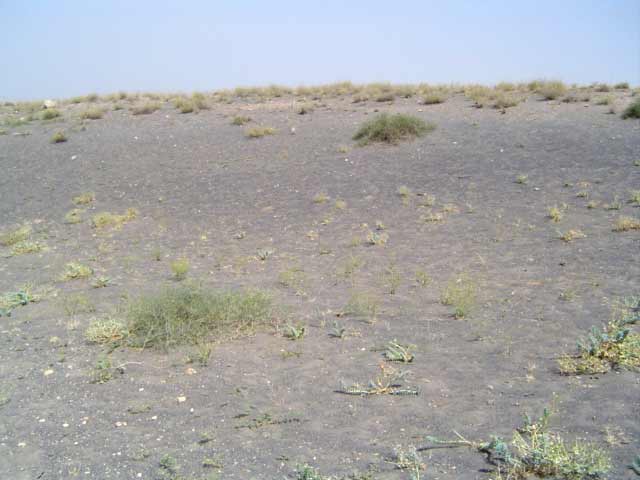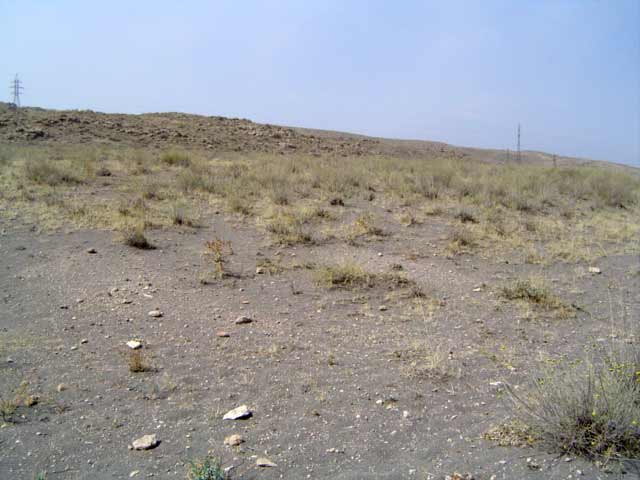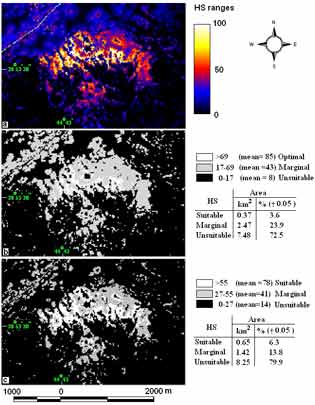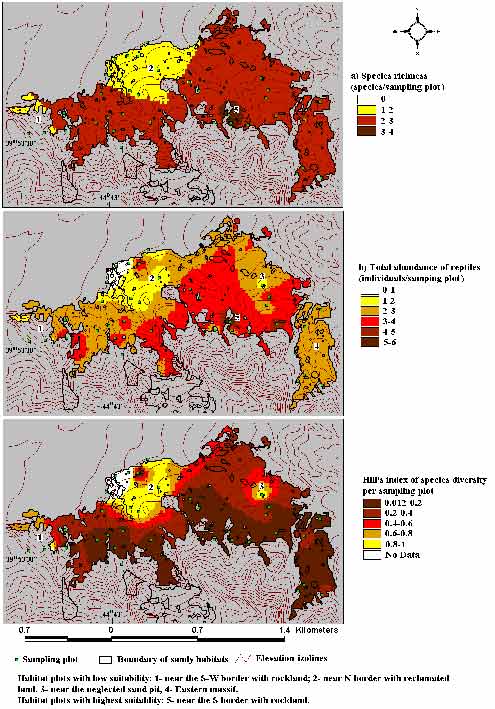Supporting Protected Areas
Goravan Sands state sanctuary
The Goravan Sands sanctuary was nominated by government of Armenian SSR in 1959. At that times it was nominated "Gorovan Sands" sanctuary, after the old name of nearest village Gorovan. Recently "Gorovan" was changed into "Goravan", and hence the name of the sanctuary also should be changed. In the literature is also possible to meat other synonym of this p.a.: The Sands of Goravan reservation.


In the Goravan Sands sanctuary P. persicus
inhabits especially sparse vegetated sandy habitats. (Photos by T.L.Tadevosyan, 2006)
Despite this area is in the center of the interest of biologists, and included in the list of hotspots by CEPF (Caucasus Biodiversity hotspot, 2003). It actually remains neglected and multidimensional using by man as pasture, stone and sand mining, illegal collection of plants and animals, as well as for waste depositing. Several peripheral patches of sandy habitat were recently reclaimed.
Goravan Sands sanctuary presents a mix of sandy, clayey, stony and rocky habitats. This habitats support about 160 species of vascular plants and 40 species of vertebrates as well as many invertebrates.
11 species of vascular plants (Calligonum polygonoides, Salsola tamamschjanae, Acantholimon araxanum, Astragalus paradoxus, Astragalus massalskii, Thesium szovitsii, Neogailonia szovitsii, Eremostachys macrophylla, Rhynopethalusm gibbosum, Tulipa biflora, Iris elegantissima) and 7 species of vertebrate animals (Reptiles: Phrynocephalus persicus, Trachylepis auratus, Eumeces schneideri, Testudo graeca armeniaca; Birds: Oenanthe finschii, Rhodopechis githaginea; Mammals, Meriones dahli) included in Red Data Book of Armenia. One species Testudo gaeca is acknowledged as vulnerable worldwide (IUCN, 2006).
According to the official data (Red Data
Book of Armenia, First
National Report on Biological Diversity) an area of the Goravan Sands
sanctuary consists of 200 ha of sandy habitats. In some other sources
there is also a data that, an area of the sanctuary is 300 (Tadevosyan,
2001), or 358 ha (Caucasus
Biodiversity hotspot, 2003). According to the recently performed field
surveys and the analysis of the LandSat 7 ca, 2000 satellite image, sandy
habitats near Goravan are presented by 10 patches with total area of nearly
175 ha (Tadevosyan, 2006a,b).
View Goravan Sands Sanctuary in a larger map
 |
According to literary data Goravan sands are presented by 200 hectares of sandy habitats spread in elevation range 850-950 m. above sea level. However, as I calculated by analysis of reclassified satellite image LandSat 7Cyrca, 2000, actually sandy habitats are presented by nearly 10 patches with total area of nearly 175 hectares. |
 |
According to literary data Goravan sands are presented by sandy habitats spread in elevation range 850-950 m. above sea level. In several sources it is possible to obtain the data that the sanctuary is situated between 1000-1200 m a.s.l. However, GPS tracking, and topographic map (1:25000) overlaid with the contour of sandy habitats suggest actual elevation range of sandy habitats between 894-1060 m above sea level. |
 |
The spatial distribution of P. persicus within the sandy habitats is not homogenic, and not random. Application of ecological-niche factor analysis (ENFA, visit http://www2.unil.ch/biomapper, for more details) allowed to produce a habitat suitability model, and predictive habitat suitability maps, which are categorize the area of the sanctuary into the several habitat suitability classes for the lizard.
|
 |
Produced reptile diversity and abundance maps show irregular character of lizard diversity in the main and eastern sandy massifs of the Goravan Sands Sanctuary. Patches with different diversity and abundance indexes may also differ in suitability for reptiles see Tadevosyan T.L. 2006. for more details. |
Currently P. persicus is under especial legal protection only within the Goravan Sands Sanctuary, which is situated in the Ararat region of Armenia (Tadevosyan, 2006a,b).
References:
Agasian A.L. (Aghasyan A.L.). 1985. [Recent Sate of Rare Spacies of Reptiles In Armenia And The Ways of Their Conservation], // Biol. J. of Armenia, XXXVIII, No 8, pp. 661-665. (In Russian)
Ananjeva N.B., Orlov N.L., Khalikov R.G., Darevsky, I.S., Rjabov S.A., Barabanov A.B., 2004. [Atlas of Reptiles of Northern Eurasia.], St. Petersburg, ZIN RAS, pp. 232 pp.(In Russian)
Danielyan F.D., 1987. Reptiles. Pp. 103-114 In Red Data Book of Armenian SSR. Movsesyan S.O., and K.A. Ayrumyan (Eds.). "Hayastan", Yerevan.
Darevsky I.S., Orlov N.L., 1988. [Rare and Endangered Animals. Amphibians and reptiles.] Handbook, Moscow, Highest School, 463 pp.(In Russian)
Tadevosyan T.L. 2005.Conservation of The Endangered Persian Sun-Watcher Lizard: Step 1. Report of the ANSEF Project 05-NS-zoo-814-50, 46 pp.
Tadevosyan T.L. 2006. Habitat Suitability for Reptiles in the Goravan Sands Sanctuary, Armenia / Herpetological Conservation and Biology, 1 (1):40-45. also available at http://www.herpconbio.org
Tadevosyan T.L. 2006. New Data on Abundance and Distribution of the Persian Toad-Headed Lizard in the Goravan Sands Sanctuary, Armenia / Electronic Journal of Natural Sciences. National Academy of Sciences of The Republic of Armenia. 2 (7):45-50.
Tadevosyan, T.L. 2007. The role of vegetation in microhabitat selection of Phrynocephalus persicus, Eremias strauchi and Eremias pleskei from Armenia. Amphibia-Reptilia 28 (3): 444-448. available at www.brill.nl/amre
Links:
Tadevosyan's Herpetological Resources
Taxonomy / Synonymy / Related taxa
Food / Competitors / Enemies / Diseases
Geographic distribution / Habitats
!